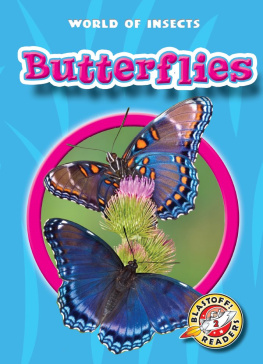Take a Close Look!
Have you ever seen a butterfly up close? What does it look like? How does it eat? What is its life cycle? When you check out the "Zoom Bubbles" on every spread of this book, you will get an up-close peek at this insect's body, eyes, antennae, wings, and more!
"THIS SERIES IS A GREAT INTRODUCTION TO THE INSECT WORLD, HIGHLIGHTING APPEALING AND FAMILIAR EXAMPLES."
Helen Hess, PhD, Series Science Consultant
Professor of Biology
College of the Atlantic
Bar Harbor, Maine
"YOUNG READERS WHO LIKE FLYING AND CRAWLING INSECTS WILL LOVE THESE INFORMATION-PACKED BOOKS!"
Allan A. De Fina, PhD, Series Literacy Consultant
Dean, College of Education/Professor of Literacy Education
New Jersey City University
Past President of the New Jersey Reading Association
About the Author
Trained as both a scientist and journalist, Melissa Stewart is the award-winning author of more than 100 books for young readers. While gathering information for her books, Melissa has explored tropical forests in Costa Rica, gone on safari in Kenya and Tanzania, and swum with sea lions in the Galpagos Islands.

chrysalis (KRIS uh liss)The hard outer skin of a butterfly pupa.
larva (LAHR vuh)The second part in the life cycle of some insects. A butterfly larva is called a caterpillar. A larva changes into a pupa.
nectar (NEK tuhr)A sugary liquid that many flowers make. Butterflies and some other insects drink it.
pupa (PYOO puh)The third part in the life cycle of some insects. A pupa changes into an adult.


Image Credit: Shutterstock.com
Butterflies live in many parts of the world. But they cant live in dry, hot deserts.
In places with cold winters, some butterflies fly to warmer areas. Others rest in safe spots all winter long.

Image Credit: lrh847/Photos.com

Image Credit: Shutterstock.com
A butterfly is an insect. An insect has six legs. Its body has three main parts.
An insects head is in the front. The thorax is in the middle. The abdomen is the part at the back.

Image Credit: Shutterstock.com

Image Credit: Shutterstock.com
A butterfly has two huge eyes. They stick out of its head. The eyes can see right and left, up and downall at the same time. What a great trick!

Image Credit: Gary Boisvert/Photos.com

Image Credit: Shutterstock.com
A butterfly has two long antennae on the top of its head. They can move up and down or side to side. They smell and feel the world.

Image Credit: Artyom Rudenko/Photos.com

Image Credit: David M. Phillips Ph.D./Science Source
Most butterflies get all their food from flowers. They sip sweet nectar with a long, thin tongue. It works like a drinking straw. Some butterflies suck juices from rotting fruit. Others drink sap from a tree.

Image Credit: pjgs/Photos.com

Image Credit: Shutterstock.com
A butterfly has two sets of wings. It uses the wings to fly from place to place.
Why do butterflies need to fly? To find lots of food and to lay their eggs in good spots.

Image Credit: Hans Christoph Kappel/NPL/Minden Pictures

Image Credit: Shutterstock.com
A butterfly has a thin, smooth coat of scales on its wings. They look like the shingles on a roof. The scales give the wings their colors. Some wings are bright and beautiful. Others blend in with leaves or tree bark.

Image Credit: Shutterstock.com
The butterfly in the top photo blends into the tree. The blue butterfly is bright and stands out!

Image Credit: Ingo Arndt/NPL/Minden Pictures
A butterfly has six legs. They are attached to the middle of its body.
A butterfly can rest on its legs. But it cant walk very well. Hairs on its feet can taste anything the insect lands on.

Image Credit: Ziga Camernik/Photos.com
The butterfly in the top photo blends into the tree. The blue butterfly is bright and stands out!

Image Credit: Shutterstock.com
What is a caterpillar? Its a young butterfly. It hatches from an egg. Then it munches on leaves and stems.
After one or two weeks, this larva looks for a safe place. It sheds its skin and becomes a pupa





































